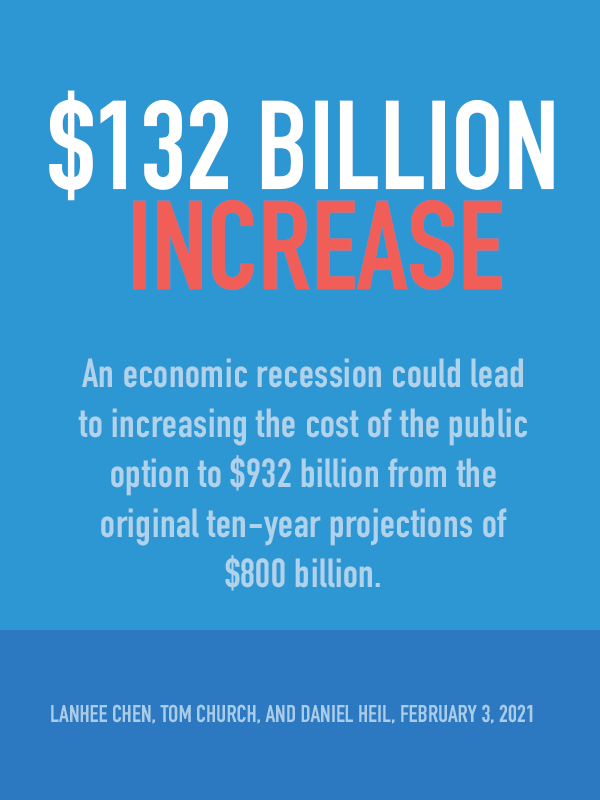New Study: During An Economic Crisis, The Public Option Could Become Even More Unaffordable For Working Families

New Government-Controlled Health Insurance System Could Require Higher Taxes On American Families During Economic Shocks & Add $932 Billion To Deficit
WASHINGTON – A new study released today by Lanhee J. Chen, Ph.D., Tom Church, and Daniel L. Heil, with support from the Partnership for America’s Health Care Future reveals that a new government-controlled health insurance system known as the public option could be more expensive for working families in the face of economic shocks. In fact, the study reveals the public option “would have significant impacts on America’s future fiscal condition,” and either “increase the federal debt or require higher taxes,” on American families.
This new study builds on an earlier analysis conducted by Chen, Church, and Heil for the Partnership, which found that the public option could increase the federal deficit by $800 billion in the first 10 years and could raise taxes on American families by more than $2,500 a year.
According to the new study, “enrollment in a politically realistic public option would quickly exceed 100 million Americans. As a consequence, relatively small economic or legislative changes could substantially increase the budgetary cost of a public option.” In the event of a future economic recession, the long-term cost of the new government health insurance system could balloon by an additional $1.4 trillion, placing an even greater financial burden on working families.
In fact, the consequences of politically realistic responses to an economic shock such as a recession could exacerbate the costs of the public option. For example, freezing premiums during a recession could increase the 2050 debt burden. “To avoid this debt increase, Congress would need to raise taxes,” and as a result, “if the public option were financed similarly to Medicare Part A, middle-income tax filers would see their taxes rise by an inflation-adjusted total of $2,833 in 2050.”
Further, providing premium relief for the unemployed during a recession “would increase the cost of the public option by 18 percent over the first ten years, raising the plan’s 10-year deficit effect to $932 billion.” Finally, if health care expenditures increase quicker than currently forecasted, the “the typical family would see their 2050 tax bill rise by an additional $1,618 (2020 dollars).”
Key Findings:
- The public option could be more expensive for working families than originally projected during economic recessions. This builds on an earlier study which found that under the public option the average American family could eventually see their payroll taxes increase by more than $2,500 a year and 10-year deficits could increase by $800 billion due to the public health crisis.
- In the event of a future economic recession, the long-term cost of the public option could balloon by an additional $1.4 trillion, placing an even greater financial burden on working families. As a result, Congress could force working families to pay an additional $300 per year, from $2,533 to $2,833 in 2050.
- Further, providing premium relief for the unemployed during a recession could increase the cost of the public option by 18 percent over the first ten years, raising the cost of the public option to $932 billion from the original ten-year projections of $800 billion.
- And, if health care expenditures increase quicker than currently forecasted, working families could see their payroll taxes increase by an additional $1,600 a year under the public option.
“This new study adds to the mounting evidence that hardworking families can’t afford the public option,” said Lauren Crawford Shaver, the Partnership’s executive director. “During this critical time, we should build on and improvewhat’s working in health care where private coverage, Medicare and Medicaid work together to expand access to health coverage and care.”
- To read the complete study, CLICK HERE.
- To learn more about the public option, CLICK HERE.
- To learn more about the Partnership for America’s Health Care Future, CLICK HERE.
About the Authors: Lanhee J. Chen, Ph.D. is the David and Diane Steffy Fellow in American Public Policy Studies at the Hoover Institution and Director of Domestic Policy Studies in Public Policy at Stanford University. Tom Church and Daniel L. Heil are policy fellows at the Hoover Institution.
About the Partnership for America’s Health Care Future: The Partnership for America’s Health Care Future’s (PAHCF) mission is to build on what’s working in health care and fix what’s not. Every American deserves access to affordable health coverage and high-quality care. Our health care system allows tens of millions of patients and families to receive world-class care delivered by world-class doctors and hospitals. But we can and must do more to ensure health care works for all Americans. That’s why the nation’s leading doctors, nurses, clinicians, community hospitals, health insurance providers and biopharmaceutical companies want to work together to lower costs, protect patient choice, expand access, improve quality and foster innovation. And whether it’s called Medicare for All, Medicare buy-in or the public option, one-size-fits-all health care will never allow us to achieve those goals. That’s why we support building on the strength of employer-provided health coverage and preserving Medicare, Medicaid and other proven solutions that hundreds of millions of Americans depend on – to expand access to affordable, high-quality coverage for every American.